2004 Uruguayan general election
General elections were held in Uruguay on 31 October, alongside a constitutional referendum.[1][2] The result was a victory for the Broad Front, marking the first time a party other than the Colorado Party or National Party had held power since the two parties were formed in the 1830s.
| |||||||||||||||||||||||||||||||||||||||||||||||||||
|
| |||||||||||||||||||||||||||||||||||||||||||||||||||
Presidential election | |||||||||||||||||||||||||||||||||||||||||||||||||||
| |||||||||||||||||||||||||||||||||||||||||||||||||||
| |||||||||||||||||||||||||||||||||||||||||||||||||||
| |||||||||||||||||||||||||||||||||||||||||||||||||||
Maps | |||||||||||||||||||||||||||||||||||||||||||||||||||
|
| |||||||||||||||||||||||||||||||||||||||||||||||||||

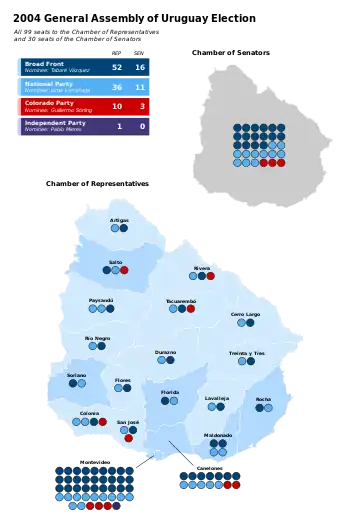
| |||||||||||||||||||||||||||||||||||||||||||||||||||
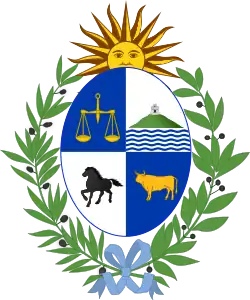 |
|---|
|
|
Broad Front leader Tabaré Vázquez was elected president on his third attempt after his party won just over 50% of the vote, enough for him to win the presidency in a single round. To date, this is the only time that a presidential election has been decided without a runoff since the two-round system was introduced in 1999. The Broad Front also won majorities in the Chamber of Deputies and the Senate.
Primaries
The Uruguayan presidential primaries were held on 27 June 2004.[3] Most parties had only one candidate running unopposed, including Tabaré Vázquez of Broad Front–Progressive Encounter–New Majority;[4] Pablo Mieres of the Independent Party; Victor Lissindi of the Intrasigent Party; Aldo Lamorte of the Civic Union; and Rafael Fernández of the Workers' Party. Jorge Larrañaga, Luis Alberto Lacalle, and Cristina Maeso competed to represent the National Party, with Larrañaga claiming the role. Guillermo Stirling defeated Alberto Iglesias, Ricardo Lombardo, Manuel Flores Silva, Eisenhower Cardoso, Jorge Ruiz, and Gustavo Boquete to represent the Colorado Party.[4] Julio Vera was chosen to represent the Liberal Party over Ramón Díaz and José Curotto.
Presidential candidates
| Party | Candidate | Ideology | Previous result | |||
|---|---|---|---|---|---|---|
| Votes (%) | Seats | |||||
| Broad Front–Progressive Encounter–New Majority | 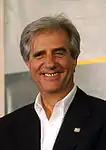 |
Tabaré Vázquez | Democratic socialism | 44.67% | 44 / 99 13 / 30 | |
| National Party |  |
Jorge Larrañaga | Conservatism | 22.31% | 22 / 99 7 / 30 | |
| Colorado Party |  |
Guillermo Stirling | Liberalism | 32.78% | 33 / 99 10 / 30 | |
| Independent Party | 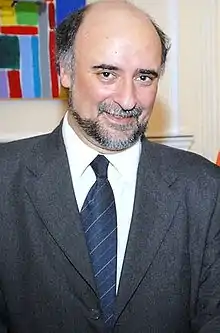 |
Pablo Mieres | Social democracy | New party | ||
Results
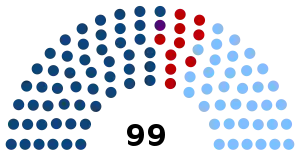  | |||||||||
|---|---|---|---|---|---|---|---|---|---|
| Party | Presidential candidate | Votes | % | Seats | |||||
| Chamber | +/– | Senate | +/– | ||||||
| Broad Front–Progressive Encounter | Tabaré Vázquez | 1,124,761 | 51.66 | 52 | +12 | 16 | +4 | ||
| National Party | Jorge Larrañaga | 764,739 | 35.13 | 36 | +14 | 11 | +4 | ||
| Colorado Party | Guillermo Stirling | 231,036 | 10.61 | 10 | –23 | 3 | –7 | ||
| Independent Party | Pablo Mieres | 41,011 | 1.88 | 1 | New | 0 | New | ||
| Intransigent Party | Victor Lissidini | 8,572 | 0.39 | 0 | New | 0 | New | ||
| Civic Union | Aldo Lamorte | 4,859 | 0.22 | 0 | New | 0 | 0 | ||
| Liberal Party | Julio Vera | 1,548 | 0.07 | 0 | New | 0 | New | ||
| Workers' Party | Rafael Fernández | 513 | 0.02 | 0 | New | 0 | New | ||
| Total | 2,177,039 | 100.00 | 99 | 0 | 30 | 0 | |||
| Valid votes | 2,177,039 | 97.64 | |||||||
| Invalid/blank votes | 52,572 | 2.36 | |||||||
| Total votes | 2,229,611 | 100.00 | |||||||
| Registered voters/turnout | 2,487,816 | 89.62 | |||||||
| Source: Corte Electoral | |||||||||
By department
| Constituency | Broad Front | National Party | Colorado Party | Independent Party | Others[lower-alpha 1] | Valid votes | Invalid votes | |||||||||||
|---|---|---|---|---|---|---|---|---|---|---|---|---|---|---|---|---|---|---|
| Votes | % | D | Votes | % | D | Votes | % | D | Votes | % | D | Votes | % | Votes | % | Votes | % | |
| Artigas | 16,220 | 32.1 | 1 | 24,517 | 48.5 | 1 | 8,563 | 16.9 | 0 | 153 | 0.3 | 0 | 49 | 0.10 | 49,502 | 97.8 | 1,090 | 2.2 |
| Canelones | 161,879 | 53.2 | 7 | 98,844 | 32.5 | 5 | 28,044 | 9.2 | 2 | 5,176 | 1.7 | 0 | 2,451 | 0.81 | 296,394 | 97.4 | 8,036 | 2.6 |
| Cerro Largo | 23,111 | 38.0 | 1 | 29,129 | 47.9 | 1 | 6,700 | 11.0 | 0 | 291 | 0.5 | 0 | 9 | 0.01 | 59,240 | 97.5 | 1,509 | 2.5 |
| Colonia | 36,677 | 41.4 | 1 | 37,302 | 42.1 | 1 | 10,136 | 11.4 | 1 | 1,527 | 1.7 | 0 | 641 | 0.72 | 86,283 | 97.4 | 2,298 | 2.6 |
| Durazno | 13,524 | 33.1 | 1 | 19,456 | 47.7 | 1 | 6,117 | 15.0 | 0 | 466 | 1.1 | 0 | 317 | 0.78 | 39,880 | 97.7 | 950 | 2.3 |
| Flores | 6,049 | 31.7 | 1 | 9,567 | 50.2 | 1 | 2,796 | 14.7 | 0 | 183 | 1.0 | 0 | 36 | 0.19 | 18,631 | 97.8 | 427 | 2.2 |
| Florida | 21,042 | 41.3 | 1 | 20,495 | 40.2 | 1 | 7,413 | 14.5 | 0 | 678 | 1.3 | 0 | 261 | 0.51 | 49,889 | 97.8 | 1,115 | 2.2 |
| Lavalleja | 14,612 | 31.7 | 1 | 22,122 | 48.1 | 1 | 7,189 | 15.6 | 0 | 761 | 1.7 | 0 | 111 | 0.24 | 44,795 | 97.3 | 1,243 | 2.7 |
| Maldonado | 46,945 | 47.8 | 2 | 36,218 | 36.9 | 2 | 9,278 | 9.4 | 0 | 2,620 | 2.7 | 0 | 553 | 0.56 | 95,614 | 97.4 | 2,568 | 2.6 |
| Montevideo | 565,974 | 61.3 | 27 | 226,552 | 24.6 | 11 | 76,099 | 8.2 | 3 | 24,933 | 2.7 | 1 | 9,545 | 1.03 | 903,103 | 97.9 | 19,672 | 2.1 |
| Paysandú | 35,053 | 45.3 | 1 | 35,357 | 45.7 | 1 | 4,720 | 6.1 | 0 | 472 | 0.6 | 0 | 45 | 0.06 | 75,647 | 97.7 | 1,805 | 2.3 |
| Rio Negro | 14,240 | 39.7 | 1 | 15,558 | 43.4 | 1 | 4,926 | 13.7 | 0 | 235 | 0.7 | 0 | 106 | 0.30 | 35,065 | 97.8 | 780 | 2.2 |
| Rivera | 21,300 | 30.0 | 1 | 32,006 | 45.1 | 1 | 15,419 | 21.7 | 1 | 347 | 0.5 | 0 | 199 | 0.28 | 69,271 | 97.7 | 1,663 | 2.3 |
| Rocha | 22,879 | 43.8 | 1 | 20,196 | 38.7 | 1 | 6,534 | 12.5 | 0 | 553 | 1.1 | 0 | 240 | 0.46 | 50,402 | 96.6 | 1,775 | 3.4 |
| Salto | 35,359 | 43.4 | 1 | 31,823 | 39.1 | 1 | 11,610 | 14.3 | 1 | 479 | 0.6 | 0 | 214 | 0.26 | 79,485 | 97.6 | 1,927 | 2.4 |
| San Jose | 29,277 | 42.8 | 1 | 29,663 | 43.4 | 1 | 6,683 | 9.8 | 1 | 799 | 1.2 | 0 | 319 | 0.47 | 66,741 | 97.6 | 1,671 | 2.4 |
| Soriano | 26,332 | 43.1 | 1 | 25,617 | 41.9 | 1 | 7,015 | 11.5 | 0 | 574 | 0.9 | 0 | 58 | 0.09 | 59,596 | 97.5 | 1,546 | 2.5 |
| Tacuarembó | 21,241 | 32.6 | 1 | 33,931 | 52.0 | 1 | 7,887 | 12.1 | 1 | 373 | 0.6 | 0 | 289 | 0.44 | 63,721 | 97.7 | 1,470 | 2.3 |
| Treinta y Tres | 13,047 | 37.5 | 1 | 16,386 | 47.1 | 1 | 3,907 | 11.2 | 0 | 391 | 1.1 | 0 | 49 | 0.14 | 33,780 | 97.0 | 1,027 | 3.0 |
| Total | 1,124,761 | 50.45 | 52 | 764,739 | 34.30 | 36 | 231,036 | 10.36 | 10 | 41,011 | 1.84 | 1 | 15,492 | 0.69 | 2,177,039 | 97.64 | 52,572 | 2.36 |
| Source: Corte Electoral | ||||||||||||||||||
Notes
- Parties which gained no parliamentary representation: Intransigent Party, Civic Union, Liberal Party, Workers' Party.
References
- Nohlen, D (2005) Elections in the Americas: A data handbook, Volume II, p494 ISBN 978-0-19-928358-3
- "2004 Uruguayan election results" (in Spanish). Corte Electoral. Archived from the original on 20 June 2016. Retrieved 6 February 2014.
- Reglamentación de las elecciones internas de los partidos políticos (in Spanish)
- "Comienzan las internas". La Onda Digital. 16 March 2004. (in Spanish)
External links
